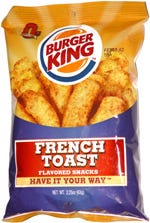Hello Class,
It’s great to see you again. I took last week off for Spring Break, and this week I return with more fast food goodness because the deep fryer pauses for no one. In case you missed it, the second part of my conversation with Adam Chandler and Ed Levine about fast food came out on the Special Sauce podcast. You can take a listen here.
This month, I’m participating in some great book events.
On April 21, I’m chatting with my dear friend, writer Beth Pickens about her new book Make Your Art No Matter What: Moving Beyond Creative Hurdles, which is a critical guide for every writer, artist, or person in the world. You can register for the event hosted by Chicago’s Women and Children First Bookstore here. The book is a wonderful follow-up to her 2018 Book Your Art Will Save Your Life. Beth is the creator of Homework Club, a resource for creatives to gather, reflect, and infuse accountability in their practice. I am a member of said club, and I have found it has helped me set writing goals, interact with some of the most talented people across the arts, and Beth gives good advice in our monthly club meetings. For the price of two Extra Value Meals, you can identify the barriers that are keeping you from finishing that novel, starting that grant application, or pitching that podcast idea.
On April 24, I’ll be in conversation with Keeanga-Yamahtta Taylor, author of two of my favorite books From #BlackLivesMatter to Black Liberation and Race for Profit: How Banks and the Real Estate Industry Undermined Black Homeownership as part of Boston University’s National Anti-Racist Book Festival. You can grab tickets here.
I’ll also be joining the good folks at Studio ATAO for a discussion of my book Franchise: The Golden Arches in Black America if you want to connect IRL, via Zoom that is, on April 27.
Anyone who knows me, knows that I live for breakfast. When I imagine a special occasion meal, you can keep your steak dinners and lobster means very little to me, unless it’s the star protein in a Benedict and I’m eating it at 10:45 in the morning. As a person with a sweet tooth, breakfast allows me to essentially eat dessert for an entire meal while still appearing like an adult. So, in the spirit of my favorite meal and the fact that in a few weeks I’ll be celebrating my wedding anniversary and lamenting that we aren’t able to toast the occasion at a fancy hotel brunch because I’m not quite indoor dining yet and COVID-19 may have effectively killed the buffet, today’s newsletter is all about fast-food breakfast.
The Egg McMuffin. Need I say more. We have the late Herb Peterson to thank for the sandwich that has fueled many an early morning car ride. The Santa Barbara-based franchisee, who had worked in advertising and in the fast food industry, developed the McMuffin to resemble Eggs Benedict without the silky Hollandaise sauce or delicate poached egg. It’s unlikely that you will mistake a McMuffin for a $23 Benedict at a fancy restaurant, but the use of the English muffin and the salty cheese slice replicates some of the flavors of the real thing. The egg patty that somewhat resembles a whisked egg and the Canadian bacon fits perfectly into a sandwich, although the original McMuffin was served open-faced. Herb was one of many franchisees whose idea to improve the McDonald’s menu led to a national leader for the brand. McDonald’s decision to offer all-day breakfast in 2015 has revealed why a lot of fast food companies restrict breakfast hours in the first place. The pressure to stock breakfast-only food products (powdered or liquid eggs, special breakfast breads and pastries, hash brown patties requiring their owns special packaging) can throw off even the most, well-organized operation, and franchisees were eventually given the authority to restrict what could be served all-day. COVID-19 supply chain issues, among other financial stresses, led McDonald’s to end all-day breakfast in the spring of 2020, although some committed franchise locations have pressed on and are serving up a McGriddle whenever you want it.

If fast food breakfast is all about taking elevated dishes and making them accessible and convenient, then the Burger King French Toast Sticks is an exemplar among its peers. French toast, also known as endless sugar for breakfast, can be a polarizing dish because without the right proportion of batter to bread you can find yourself eating sad, grilled toast or a sweet omelette. But, Burger King hits the right flavor notes to make you believe that you are indeed eating French Toast with your bare hands, with a sweet, crisp bread base and the best artificial syrup that a few bucks can buy. Since 1979, Burger King has experimented with a number of breakfast ideas, and the French Toast Sticks inspired a brief foray into French Toast sandwiches in 2019, but this product never made it to primetime. Perhaps it was too much of a good thing. Ultimately, the McDonald’s McGriddle sandwich, introduced in 2003, probably comes closest to living the dream of the foregone French Toast sandwich in serving eggs and meat inside of a pancake-inspired bun. But, the Burger King Crossain’wich, introduced in 1983 (and now available in double size), has been able to survive over the years, and the slightly sweet bread for these sandwiches provides the salty-savory flavor combination that makes breakfast foods so appealing.

The legacy fast food brands have been offering breakfast for decades now, and relative newcomer Taco Bell had a lot of ground to cover when it launched its morning menu in 2014. The popularization of the breakfast burrito among brands meant that Taco Bell had a bit of a template to work with when it entered the breakfast market, but Taco Bell decided that it would make a splash by creating its own lexicon of breakfast. Case in point, the breakfast quesalupa, which Eater claims was inspired by a pupusa and a quesadilla, with the essence of a breakfast taco. Other menu items included a Isle of Dr. Moreau-style biscuit taco. The Taco Bell breakfast was also axed due to COVID-19 realities, including a dwindling number of morning customers, but is on track to return. Perhaps the best public health intervention possible to encourage vaccination and continued vigilance would be a reminder that quesalupas await us all when we finally stop the spread.

When is a biscuit not a biscuit? When it’s a taco? I’m also confused. Photo via Eater. No conversation about breakfast would be complete without a mention of donuts, or morning cake. The franchise formerly known as Dunkin’ Donuts, and currently known as Dunkin’, played a formative role in my years living in Providence, Rhode Island in the early 2000s when I was a graduate student at Brown. Considering the downtown sports arena was affectionately called The Dunk, Dunkin’ Donuts was how Ocean Staters oriented themselves in navigating driving directions and navigating life. Coffee-and-donuts are an incredibly polarizing issue, so I will not make any statements about the quality of either in regards to Dunkin’. But, as a national and international brand, Dunkin’ Donuts is a fascinating case study in adapting to changing tastes in an incredibly narrow food category. For the majority of its existence, donuts led its market recognition, but growing concerns about diet and the soundness of eating a deep fried dessert first thing in the morning required Dunkin’ to shift its menu. In the 1990s, the shift toward bagels was a costly and risky move for a donut brand, but the bagel craze of the era indicated that customers perceived bagels as a healthier start to their morning than bagels, and their ability to be used all day long as sandwich bread made them an attractive gamble. New Yorkers who are reading this, I’m not suggesting that Dunkin’ bagels are the greatest, but after a few trials with frozen, Lender’s bagels to parcooked ones baked inside the stores, Dunkin’ has been able to find a place among the other bagel chains at your local airport. The other notable pivot was the recent decision in 2019, to rebrand as simply Dunkin’ to emphasize their place in the beverage market. The rise of Starbucks, which despite its color scheme should be considered fast food, has made all fast food companies see coffee as the place to build brand loyalty and allow a secondary place of menu innovation.

Fred the Baker, was the face of Dunkin’ Donuts from 1981-1997. His tagline “Time to Make the Donuts,” was iconic, and when I say it, my students wonder what I’m talking about. Fellow educators, many of you know about the importance of how you start your classes—the opening questions, the announcements, the reminders—but do you ever think about how you close? Over the years, I’ve experimented with different ways of ending class. Sometimes, I’m engaged in a mad scramble to get all the information out as fast as possible before the time period ends, and with the move to Zoom school, I sometimes find myself done earlier than anticipated because I don’t have as many students weighing in with comments and questions. Either way, on my more thoughtful days, here are some of the best ways I close a class period.
Teasers: Lately, I’ve been trying to include a final slide to ‘tease’ the next week’s reading material. Considering the exhaustion we are feeling right now, making a case for the excitement of the next week’s reading helps. My favorite thus far, a preview of an article on French, colonial schemes to send potential wives to Louisiana to marry the settler-colonists in the region: “Like the Bachelor, But Make it Colonial.” This is why I stick to history mostly.
Something to Keep in Mind: Ask students to reflect on what receiving new information helps them better understand about themselves, the world around them or a current event. “Now that we’ve learned about the history of residential segregation, how does this inform or deepen your understanding of the neighborhood you grew up in?” or “Now that we discussed this, what are you better equipped to discuss or do?”
Sharing is Caring: Ask students to consider the people in their lives they would like to share what they’ve learned with or introduce an idea to. This helps students understand that learning allows us to be more connected to people who are important to us, but many not be learning alongside us.
Now You See It: Ask students to come to the next class session prepared to articulate the ways that what they have learned in class is visible outside of the classroom. “Do you notice certain patterns and shapes in ‘the outside world?’ “ “Do you understand references on the nightly news that you didn’t understand before?” “Do you see the link between this one class and other classes?”
A Deep Breath: Regardless of what we teach, sometimes we need to just take a moment. As someone who often lectures about the very worst aspects of society—racism, misogyny, violence—I need to take a deep breath to ground myself. It helps to invite students to do the same. We are all a little better for it when we remember to pause and be still.
I hope that spring is bringing all of you a little relief and a lot of beautiful things.
Until next time,
Your Favorite Prof

